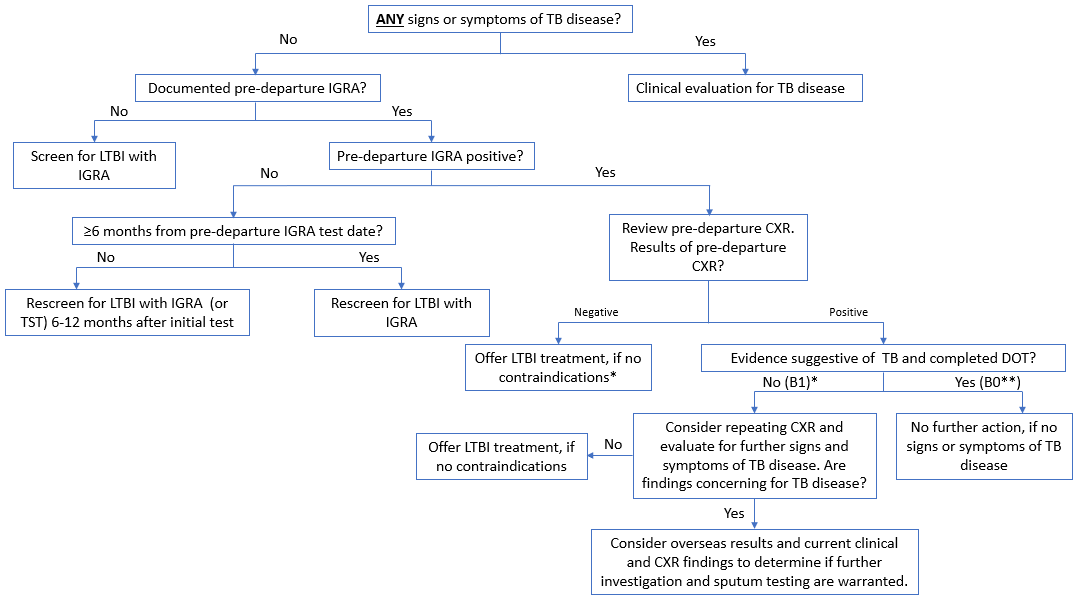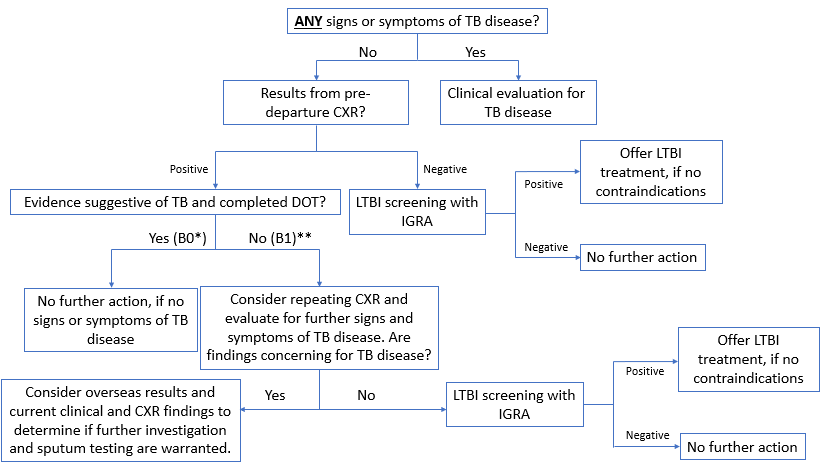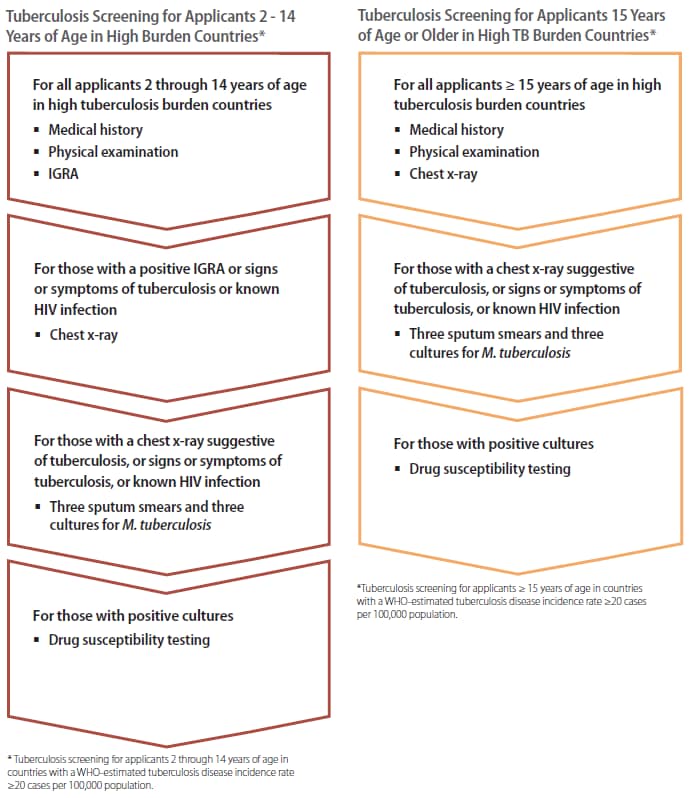Guidance for Screening for Tuberculosis Infection and Disease during the Domestic Medical Examination for Newly Arrived Refugees
- As part of the domestic screening, all overseas medical records should be reviewed, a thorough medical history obtained, and a physical examination completed.
- All refugee applicants (aged ≥2 years) must undergo evaluation overseas for tuberculosis (TB) and are assigned one or more TB classifications prior to departure. Overseas TB screening results, treatment, and classifications are documented on the US Department of State (DS) forms.
- Domestic TB evaluation for newly arrived refugees from endemic countries:
- For children aged 2–14 years:
- If Interferon Gamma Release Assay (IGRA) was negative overseas (within the last 6 months), and there are no signs or symptoms of TB disease upon physical examination, no further domestic evaluation is needed.
- If the overseas IGRA was negative but performed ≥6 months prior to the domestic examination, repeat IGRA.
- Treatment for latent tuberculosis infection (LTBI) should be considered after TB disease is ruled out for those with positive IGRA results, unless TB disease or LTBI treatment was completed prior to arrival.
- For children aged <2 years, a tuberculin skin test (TST) is recommended (if not previously treated for LTBI or TB disease).
- For refugees aged ≥15 years:
- If IGRA was not done overseas or a negative IGRA was documented >6 months prior, an IGRA is recommended at the domestic examination.
- If overseas or domestic IGRA is positive, LTBI treatment should be considered after TB disease is ruled out (if not previously treated for LTBI or TB disease).
- Any refugee, regardless of country of origin, with signs or symptoms of TB disease should undergo clinical evaluation for TB disease
- For children aged 2–14 years:
- Differentiating between LTBI and TB Disease (Pulmonary)
| A Person with LTBI | A Person with TB Disease |
|---|---|
|
|
|
|
|
|
|
|
|
|
|
|
Scope
This guidance briefly describes the overseas TB medical screening process for refugees resettling to the United States and outlines the evaluation of newly arrived refugees for TB during the domestic medical screening examination. This document supplements guidelines for the general US patient population, and highlights specific needs among refugees to be used in conjunction with current guidelines from national authorities (American Thoracic Society [ATS]/Centers for Disease Control and Prevention [CDC]/ Infectious Diseases Society of America [IDSA]) and state TB control programs.
Background
From 2018 to 2019, the number of TB disease cases in the United States decreased by 1.2% [1]. Additionally, in 2019, the TB rate was 2.7 per 100,000 people, the lowest rate on record [1]. While TB is decreasing overall in the United States, country of birth continues to be a major risk factor for TB in the United States, with the majority of reported TB cases occurring among non-US born persons (71.4%) [1]. The prevalence of drug-resistant TB or extrapulmonary TB cases, which are more challenging to diagnosis and manage, is also higher among foreign-born persons [2]. Studies have indicated that reactivation of LTBI, rather than recent transmission, is the primary driver of TB disease in the United States, accounting for >80% of all TB cases [2].
Additionally, 13.5% of cases among non-US born persons occurred within one year of arrival in the United States [1]. It is important to identify and treat new arrivals with LTBI soon after arrival [3]. The risk of TB disease appears to remain high for many years after resettlement, making it essential that clinicians find and treat LTBI before TB disease develops [4]. Healthcare providers who serve refugees should maintain a high index of suspicion for TB disease even long after arrival [5]. CDC and the US Preventive Services Task Force (USPSTF) recommend LTBI screening and, if positive, treatment for LTBI for persons who were born in, or have lived in, countries with high TB prevalence [6, 7].
Overview of Overseas Tuberculosis Screening for Refugees
Before departure for the United States, all refugees must undergo an overseas medical examination that focuses on inadmissible conditions, including TB disease. By law, refugees diagnosed with an inadmissible condition are not permitted to depart for the United States until the condition has been treated. CDC stipulates the content of this examination through Technical Instructions (TIs) issued to panel physicians and organizations that perform the medical screening examinations. Figure 1 outlines the required TB screening components for refugees being resettled to the United States from countries with a high burden of TB. CDC defines high burden for the purposes of screening as any country with a WHO-estimated TB disease incidence rate of ≥20 cases per 100,000 population.
Figure 1. Tuberculosis screening for applicants in high tuberculosis burden countries
Source: CDC Division of Global Migration Health, Tuberculosis Technical Instructions for Panel Physicians
Note: All applicants <2 years of age living in high burden countries must have a physical examination and history provided by a parent or guardian. Applicants who have signs or symptoms suggestive of TB disease or have known HIV must have an IGRA or TST and a chest x-ray (CXR). Applicants with signs or symptoms suggestive of TB disease must provide three sputum specimens to undergo microscopy for acid-fast bacillus (AFB), as well as culture for mycobacteria, and drug susceptibility testing for positive cultures.
Classifications and Travel Clearance
All refugee applicants must be assigned one or more TB classifications. TB classification is determined by screening results, and treatment, if required. Table 2 describes the TB classifications and travel clearance for all refugee applicants.
Table 2. TB Classifications and Travel Clearance
| Classification | Clinical Findings | Travel Clearance |
|---|---|---|
| No TB Classification | Applicants without current clinical findings of TB disease, without known HIV infection, and with a normal chest x-ray (and for applicants who require it, a negative IGRA) with normal TB disease screening examinations. | Travel clearance is valid for 6 months from the time the evaluation is complete. |
| Class A TB Disease | All applicants who have TB disease, including applicants with extrapulmonary TB who have CXR findings suggestive of pulmonary TB disease regardless of sputum smear and culture results. | Applicants are not cleared for travel until completion of treatment unless a waiver is granted |
| Class B0 TB, Pulmonary | Applicants who were diagnosed with TB disease by the panel physician or presented to the panel physician while on TB treatment and successfully completed Division of Global Migration Health (DGMH)-defined DOT* under the supervision of a panel physician prior to immigration.
|
Travel clearance is valid for 3 months from the date final cultures are reported as negative. |
| Class B1 TB, Pulmonary | Applicants who have signs or symptoms, physical exam, or chest x-ray findings suggestive of tuberculosis disease, or have known HIV infection, but have negative AFB sputum smears and cultures and are not diagnosed with TB disease. This classification also includes applicants who were diagnosed with TB disease by the panel physician, refused DOT treatment, and are returning after treatment and completion of 1-year wait. | If all parts of the examination are complete, travel clearance is valid for 3 months from the date final cultures are reported as negative. |
| Class B1 TB, Extrapulmonary | Applicants diagnosed with extrapulmonary TB with normal CXR findings and negative sputum AFB smear results and cultures. | Travel clearance is valid for 3 months from the date final cultures are reported as negative. |
| Class B2 TB, LTBI | Applicants who have a positive IGRA or TST but otherwise have a negative evaluation for TB. Documentation of IGRA or TST results, LTBI treatment status, medications used should be documented. Contacts with a positive IGRA or TST ≥5 mm will receive B2 classification in addition to a Class B3. | Travel clearance is valid for 6 months from the time the evaluation is complete. |
| Class B3 TB, Contact Evaluation | Applicants who are a recent contact of a known TB disease case, regardless of IGRA or TST results. If the IGRA or TST is positive and there is no evidence of TB disease, there will be two classifications, B2 and B3; if negative, B3 only. Additional information can be found in the Contacts of Tuberculosis Cases section. | Travel clearance is valid for 6 months from the time the evaluation is complete. |
*Directly observed therapy (DOT) is the required form of treatment for applicants diagnosed with tuberculosis disease during medical screening. Treatment of tuberculosis disease must be administered following Division of Global Migration Health (DGMH)-defined DOT policies and practices during the entire course of therapy.
Note: Applicants can be both Class B1 and Class B3, or Class B2 and Class B3. However, other combinations of TB classifications are not permitted.
Documentation of Overseas TB Evaluation
Panel physicians must document TB screening and treatment results on the DS 2054 (Medical Examination), DS 3030 (TB Worksheet), and DS 3026 (Medical History and Physical Examination Worksheet). All medical documentation must be included with the required DS forms. Refugees receive copies of these documents and should provide them to the evaluating provider in the United States. In addition, the information is available through CDC’s Electronic Disease Notification (EDN) system to state or local health departments. Evaluating providers in the United States who are not receiving this information should contact the State Refugee Coordinator or state refugee health program for guidance. Overseas medical documents include information pertinent to the TB evaluation, such as—
- Pre-resettlement medical screening evaluations
- Medical history and physical examination
- The IGRA laboratory report (if the test was indicated) or TST documentation (including name of product, expiration date, amount administered) if IGRA is not licensed in the country where screening is conducted
- Digital CXR file for all applicants aged ≥15 years and, when indicated, for younger applicants
- Sputum smear and culture results for TB, if required
- Overseas treatment information
- DOT regimen received, including doses of all medications, start and completion dates, and periods of interruption
- Radiology reports of CXR findings before, during, and after treatment
- Clinical course, such as clinical improvement or lack of improvement during and after treatment
- Laboratory results
- Sputum smear AFB microscopy results obtained before, during, and after treatment
- Reports of cultures for mycobacteria obtained before, during, and after treatment, including reports of contamination
- Drug susceptibility test results for an tuberculosis isolate
- IGRA laboratory report, including all numeric values
Domestic Refugee Screening for Tuberculosis
All refugees, including those classified with a TB condition overseas, should receive a comprehensive domestic medical screening within 90 days of arrival. The goal of the domestic screening for TB is to find persons with LTBI, in order to facilitate prompt treatment and control, and to find persons who may have developed TB disease since the overseas medical examination.
Medical History and Physical Examination of Refugees for Tuberculosis during the Domestic Medical Screening Evaluation
TB disease should be encountered infrequently during the domestic medical screening examination because all new arrivals have been screened for TB disease prior to departure. Clinicians should be aware that the overseas medical exam is aimed at diagnosing pulmonary TB disease and may fail to detect extrapulmonary disease. Therefore, it is important for clinicians to perform a thorough history and physical examination aimed at identifying any refugee who may have pulmonary or extrapulmonary TB disease. Some persons with TB disease have minimal symptoms, and a high index of suspicion should be maintained for those with any concerning history, such as household exposure to TB, or signs of active disease.
Symptoms of pulmonary TB are often indolent and nonspecific, and include malaise, weight loss, night sweats, cough, chest pain, fever, and hemoptysis. Symptoms of extrapulmonary TB disease generally reflect the organ involved (e.g., abdominal pain with gastrointestinal TB). Although extrapulmonary TB can be found in nearly any organ of the body, lymph nodes, including those in the thorax, are the most common extrapulmonary sites.
All predeparture medical records for the refugee should be closely reviewed. A thorough post-arrival medical history should be obtained. In addition to current signs or symptoms of TB disease (e.g., weight loss, night sweats, fever, cough), specific information may be helpful in recognizing persons who might have TB disease or LTBI:
- Previous history of TB
- Prior treatment suggestive of TB treatment
- Prior diagnostic evaluation suggestive of TB
- Family or household contact with a person who has or had TB disease, treatment, or diagnostic evaluation suggestive of TB
In addition, in children, a history of recurrent pneumonias, paroxysmal wheezing, failure to thrive, or recurrent or persistent fevers should increase the index of suspicion.
For general guidance on the physical examination, see History and Physical Examination Screening Guidance. The examination for TB should focus on inspection and palpation of all major palpable lymph node beds and a careful skin examination, as it may reveal cutaneous disease, scars from scrofula or bacille Calmette-Guérin (BCG) vaccination, or hints of prior chest surgery.
Testing Newly Arrived Refugees for TB Infection and Disease
The overseas medical exam is universal for all refugees. Results of overseas TB testing and treatment should be available to domestic clinicians for review for all refugee arrivals from TB endemic countries.
For children 2 to 14 years of age coming from endemic countries (TB incidence rate of ≥20 cases per 100,000 population), an IGRA result should be available. If the IGRA was negative and performed <6 months before departure, and if the child has no signs or symptoms of TB disease upon physical examination, no further evaluation is needed. Additionally, if the IGRA was positive and the child completed TB disease or LTBI treatment prior to the domestic examination and has no signs or symptoms of TB disease upon physical examination, no further evaluation is needed. If the IGRA was negative but performed ≥6 months prior to the domestic examination, a repeat IGRA should be performed. For children aged <2 years from endemic countries, LTBI testing is recommended, if not previously treated for TB disease or LTBI. Currently, TST is the preferred test for children age <2 years. Skin testing and interpretation should be done in accordance with the ATS/CDC/IDSA Clinical Practice Guidelines: Diagnosis of Tuberculosis in Adults and Children.
Refugees >15 years of age are universally screened with a CXR prior to arrival in the US. Refugees >15 years of age who have clinical signs or symptoms of TB disease, or have a positive CXR, or who are HIV positive, will have had three sputum smears and three sputum cultures performed prior to arrival. If they are diagnosed with TB disease, they receive full DOT prior to arrival. If a refugee ≥15 years has LTBI diagnosed prior to arrival but has not received LTBI treatment, they should be offered treatment if they have no current no signs or symptoms suggestive of TB disease and no contraindications to treatment. A refugee aged >15 years who had a normal CXR prior to departure should be offered an IGRA if—
- overseas IGRA was not performed
- overseas IGRA results are unavailable or
- overseas IGRA screening was performed >6 months prior and results were negative.
Any new arrival, regardless of country of origin, with signs or symptoms of TB should undergo clinical evaluation for TB disease.
Figures 2 and 3 outline the domestic screening algorithms for most refugee children aged 2–14 years and refugees aged >15 years, respectively. Further information regarding domestic screening is detailed below.
Figure 2. Domestic screening protocol for refugees who had an IGRA test prior to departure (most children aged 2–14 years)

*In rare circumstances, refugees may receive LTBI treatment prior to departure. In this case, if no signs or symptoms of TB disease, further evaluation is not needed.
**Refugees that received tuberculosis therapy as DOT, carefully supervised by a US panel physician, will be classified as B0. Those treated outside the panel physician system will be classified as B1 TB, Pulmonary. State and local TB officials will be notified via the EDN of arrivals with Class B status.
Note: Either IGRA or TST are acceptable tests. However, IGRA is preferred for children ≥5 years of age.
Figure 3. Domestic screening protocol for refugees who did not have overseas IGRA testing but had a CXR (most refugees aged >15 years)

* Refugees that received tuberculosis therapy as DOT, carefully supervised by a US panel physician, will be designated with a B0 classification. Those treated outside the panel physician system will be classified as B1 TB, Pulmonary. State and local TB officials will be notified via the EDN of arrivals with Class B status.
**In rare circumstances, refugees may receive LTBI treatment prior to departure. In this case, if no signs or symptoms of TB disease, further evaluation is not needed.
Note: Either IGRA or TST are acceptable tests. However, IGRA is preferred for persons ≥5 years of age.
When domestic LTBI screening is offered, either IGRA or TST are acceptable tests (IGRA is preferred for those aged ≥5 years). A summary of recommended uses, benefits, and limitations for IGRA and TST can be found in the ATS/CDC/IDSA Clinical Practice Guidelines: Diagnosis of Tuberculosis in Adults and Children It should be noted that a negative IGRA or TST result does not eliminate TB disease from the differential diagnosis in a patient with signs or symptoms of TB disease. Additionally, a positive test result, from either IGRA or TST, should be accompanied by an evaluation for TB disease with a thorough history and examination for signs and symptoms, and a CXR.
TB Blood Tests (Interferon Gamma Release Assay [IGRA])
An IGRA is a blood test used to determine if a person is infected with M. tuberculosis. IGRAs measure the immune response to TB proteins in whole blood. Currently, QuantiFERON®-TB Gold Plus (as of March 2020 manufactured by Qiagen) and T-SPOT®.TB (Oxford Immunotec) are the two IGRAs currently approved in the United States. It is important to note that TB blood tests should not be performed on a person who has written documentation of either a previous positive TB test result (TB blood test or TST) or treatment for TB disease.
For additional information on TB blood tests, refer to the Latent Tuberculosis Infection, A Guide for Primary Health Care Providers [PDF – 60 pages].
Mantoux Tuberculin Skin Test (TST)
In otherwise healthy refugees from areas of the world where TB is common, ≥10 mm of induration is considered a positive result. A cutoff of ≥5 mm of induration is considered a positive result in persons with HIV infection, those with recent close contact with a known case of infectious TB, persons with fibrotic changes on CXR consistent with prior TB, persons with organ transplants, and other immunosuppressed persons. Many refugees from TB-endemic areas have been vaccinated against TB with BCG vaccine. IGRA is preferred for testing persons who have been vaccinated with BCG. Although previous BCG vaccination may influence TST results, especially in infants, a history of vaccination with BCG should not influence interpretation of TST results in adults. Many refugees will believe their test is positive due to past BCG vaccination. Clinicians should be prepared to thoroughly explain to the patient the reasons for not considering BCG vaccination in the interpretation of TST or IGRA results.
TST testing can be performed in all persons, including children and pregnant women. However, the test is contraindicated for persons who have had a local reaction with blistering or a systemic allergic response. False negative results may be more frequent in young children and in persons with a compromised immune system. False negatives also may occur more commonly in populations with highly prevalent M. tuberculosis infection (a high pretest probability). A TST should be administered and read by a specifically trained healthcare provider. For additional information about performing a TST, visit the CDC TB website.
Diagnostic Evaluation
Chest Radiography
Any patient with signs or symptoms of TB disease should have a CXR. If recent CXRs from the overseas medical exam are available and there has been no change in clinical status (no new signs or symptoms of pulmonary or extrapulmonary TB disease), there is no need to repeat the CXR. However, clinical judgment should be used in each case. If documentation is not available at the initial screening visit, providers should contact their State Refugee Coordinator, or the CDC (MHINx@cdc.gov) to obtain overseas testing results. If overseas CXR results cannot be obtained, or the test was done >6 months prior and the result was negative, repeat CXR should be performed.
A posterior-anterior (PA) radiograph should be the primary image obtained in adults and older children. In children too young to cooperate with PA positioning, an anteroposterior (AP) view should be obtained. Additionally, a lateral chest radiograph is recommended in children <10 years old, because hilar adenopathy, a common pediatric TB finding, can be difficult to visualize on a PA or AP view. Any new CXR should be compared to previous films. Pregnant women with a positive TST or IGRA or other CXR indication should be protected with wraparound abdominal and pelvic lead shielding during chest radiography.
When the CXR has suspicious findings, or other signs or symptoms of TB are present, sputum specimens must be collected for smear and culture testing. Further information on testing can be found in the ATS/CDC/IDSA Clinical Practice Guidelines: Diagnosis of Tuberculosis in Adults and Children.
Confirmed LTBI
Some states require LTBI reporting. Refugees with positive IGRA or TST results and normal findings on CXR should be offered LTBI treatment in accordance with CDC guidelines [8]. Information on how to choose the most effective treatment regimen for each patient, adverse drug effects, monitoring, and assessing adherence is available on the CDC TB website.
Suspected or Confirmed TB Disease
Screening results indicating TB disease may include a combination of a positive results from IGRA or TST, abnormal findings on CXR, pathology findings consistent with TB disease (e.g., caseating granuloma), signs or symptoms consistent with TB disease, sputum or tissue smear positive for AFB, a positive nucleic acid amplification test performed on the initial respiratory specimen, or a culture positive for M. tuberculosis. Prompt treatment should be initiated in consultation with a specialist for presumptive or confirmed clinical TB disease. All presumptive or confirmed cases (pulmonary or extrapulmonary) should be reported to the local health authorities within 24 hours of determination so that appropriate public health measures can be implemented, and management with an infectious disease or TB expert is recommended. Culture confirmation is not needed before starting therapy for cases with a high index of suspicion. When pulmonary or laryngeal TB is suspected, the patient should be isolated in an appropriate setting to prevent spread of infection until the patient is no longer considered infectious.
Overview of Treatment
A complete discussion of treatment for TB disease and LTBI is beyond this scope of this guidance document. CDC treatment guidelines call for clinicians to not only prescribe an appropriate regimen (length of course of treatment and treatment regimen), but also ensure adherence to the regimen until treatment is completed. TB disease should be diagnosed and treated in consultation with the public health department and TB medical experts.
Treatment Guidelines
- Guidelines for the Treatment of Latent Tuberculosis Infection: Recommendations from the National Tuberculosis Controllers Association and CDC, 2020
- Official American Thoracic Society/Centers for Disease Control and Prevention/Infectious Diseases Society of America Clinical Practice Guidelines: Treatment of Drug-Susceptible Tuberculosis
Sources of Additional Information
Additional information regarding tuberculosis can be found on the CDC TB website.

